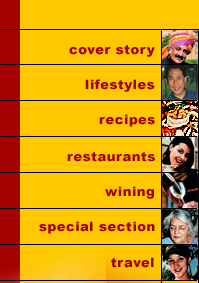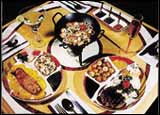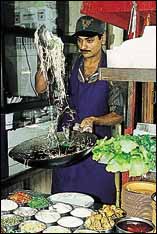

|
Norwegian Salmon
& Sassoon Dock Pomfret
I AM not keen on fusion food, enchiladas stuffed with chicken tikkas or roasted coconut flakes in Caesar's Salad, but there are some interesting experiments on at the Sidewok, the restaurant of the NCPA at Nariman Point, where the serving staff forms a chorus line and sings and dances every couple of hours.
In the evenings they serve a pink salmon, flown in direct from the fiords of Norway. It arrives in fillets, at zero temperature (not frozen, because ice formation kills the taste), and fresh stocks arrive weekly. Go on a Tuesday, that's when the new lot has just arrived.
Now here's the fusion part: the salmon is marinated in tandoori spices (sacrilege! perhaps), not too much to smother the delicate flavour of the meat, then grilled in the tandoor. It is served with thin potato slices, spiced with curry powder, fennel, onions and mustard seed, and eaten with mini naans, the size of a chef's hand.
The Norwegians do not know what
they are missing,
they should start
tandooring it in Oslo restaurants.
And the lemon grass pomfret, a full pomfret, head, bones, tail, everything, marinated in fresh ginger, garlic, chillis, salt and pepper, and crisply fried. With the bones inside, like coat hangers, the skin retains its tautness and becomes crisp and the meat gets cooked evenly. The pomfret is then tossed in powdered lemon grass and spring onion. Don't forget to eat the head, crunch through it.
And order your favourite beer, Holland's Heineken, USA's Budweister, Singapore's Tiger, Thailand's Singha, China's Tsing Tao or Vijay Mallya's Kingfisher. Yes, it is time for the waiters to line up with their song and dance.
A biryani with Bombay taste
ONE of the largest collection of biryanis, outside Mohamedali Road, may be found at Haji Ali's Cafe Noorani, a little distance from the Piramal's shopping mall. From this large collection I choose the chicken reshmi tikka biryani. A good choice sayys Faridbhai Abdul Latif Noorani, the proprietor.
It is a gentle biryani, delicate in taste, the masala is on the malai side, cream and caju gravy, crushed badam, a touch of saffron. The chicken pieces, boneless, since it is a tikka, are marinated in white masala, then grilled, then cooked in the biryani. The rice is not put on dum, and it does not stick to the meat, which makes it oily. It is not spicy, but not bland also. I shall allow Mr. Noorani to have the last word -- "It is Bombay taste."
Batata Pauha for breakfast
IF you are on a government tour of Maharashtra state, you will find yourself sleeping under mosquito nets in circuit houses every night and having batata pauha for breakfast in the morning, prepared by the khanshama. Pauha is Maharashtra's eggs and bacon, and very good and healthy.
However, you don't have to go to a circuit house to eat pauha, you may go to the Vinay Health Home at Thakurdwar, off Girgaum (Balasaheb Jayakar Marg). Apart from being one of the few genuine Maharashtrian restaurants in Bombay, it is also the oldest, and arguably serves the most authentic pauha. So what's special about this pauha? The ingredients are of the best quality, old Mr. Tembe, the founder-proprietor had instructed his sons to serve their customers the same food they would serve themselves and their children.
After all, he had called his restaurant a health home. The pauha is soaked in warm water for a long time to soften it. Meanwhile the masalas are cooked separately, sugar and onions for sweetness, chopped chillis and curry pattas for tartness, and pieces of potatoes for body. The cooked masalas are removed from the fire and the soaked pauha introduced into them.
Though it gets cooked in this manner, it does not touch the fire at all, that's the trick. It is like a spicy porridge or a tame bhel, served in a bowl and eaten with a spoon, it makes the tea taste better. And around you, Girgaum gets up to another day.
There are other Maharashtrian items, mishal, dahi mishal, puneri mishal, sabudane vade and sabudane khichdi for the month of Shrawan, patal bhaji and usal pau. Specialities are written on the walls, but back to front, so that the customers may read them correctly from the mirror opposite. It is called mirror image, Mr. Tembe's successor explains, third generation. Or is
it fourth?
Eating out on the Mumbai-Goa Road
I HAVE often taken the high road from Muumbai to Goa, stopping for breakfast, lunch nd dinner on the way. At the hotel on the hill at Chiplun, with the river down in the gorge, it is still Bombay food, but beyond, at Raigad, Ratnagiri, Savantwadi (I may have got the order wrong), the food turns Gomantak, that's Hindu Goan. By nightfall you hit Mapusa, the first town in Goa, and it becomes Christian Goan.
You may think it is the same food, but there is a lot to distinguish between Hindu and Christian Goan food. I like both, tamarind and toddy vinegar, sol kadi and Arlem beer, coconut milk and grated coconut.
In Mumbai, for Christian Goan food, I head for Goa Portuguesa at Mahim, two cabelleros play the violin and the food comes wrapped in red richad masalas. For the Hindu Goan food, the Gomantak, I proceed a little further to the gates of Bandra, to Saayba. It is a tightly packed little restaurant, much in demand.
It serves oysters on Wednesdays, Fridays and Sundays, and probably the only restaurant in town to serve a karandi fry masala, which must be the tiniest prawns on earth, much more tasty than their more opppulent cousins. Saayba also passes the two tests for a West Coast seafood restaurant, the Bombay ducks are large and fluffy and
done in rice flour, and, second test, the fish curry is bright red in colour and has a
velvety touch to it, the ingredients have been throughly mixed, not a grain of masala enters the mouth, and it is spicy and makes me perspire in spite of the
new air-conditioning installed by the management.
|

Home Page
About the mag
Subscribe
Advertise
Contact Us



